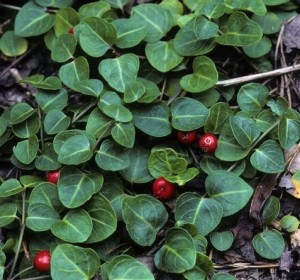Squawvine is a herb. The stem and leaves are used to make medicine.
Contents
Uses
The plant was used to ease menstrual cramps, strengthen the uterus for childbirth, and preventmiscarriage. During the final 2 to 4 weeks of a Native American woman’s pregnancy, she drank tea made from squawvine leaves so that childbirth was less painful.
In folk medicine, squawvine continued to be a remedy for women’s disorders. In addition to conditions related to childbirth, the herb was used to treat postpartum depression, irregular menstruation, and bleeding. In addition to treating internal ailments, a squawvine wash was said to provide relief to sore eyes. Squawvine is still used in folk medicine to treat conditions including anxiety, hemorrhoids, insomnia, muscle spasms, edema, and inflammation.
Benefits
People take squawvine for anxiety, diarrhea, water retention (edema), low urine output,varicose veins, sleep problems (insomnia), congestive heart failure, kidney failure, liver failure, severe diarrhea (chronic dysentery), and colitis.
Women take it for treating menstrual disorders, “lumpy breasts” (fibrocystic breast disease), and vaginal discharges. They also use it to ease childbirth, treat depression after childbirth, and improve the flow of breast milk. Squawvine has also been used to cause abortions.
Some women apply squawvine directly to the skin for treating sore nipples.
Caution
Squawvine seems safe for most people when taken by mouth in appropriate amounts.
There isn’t enough information to know whether it can be safely used on the skin.
Special Precautions & Warnings:
Pregnancy and breast-feeding: It’s UNSAFE to use squawvine if you are pregnant. There is some evidence that it might cause a miscarriage.
It’s also best to avoid squawvine if you are breast-feeding. Not enough is known about how it might affect the nursing infant.
Interactions
None are recorded.
Other names
Checkerberry, Deerberry, Hive Vine, Mitchella Rampant, Mitchella repens, Noon Kie Oo Nah Yeah, One-Berry, Pain de Perdrix, Partridgeberry, Running Box, Squaw Berry, Trébol de Invierno, Twinberry, Two-Eyed Berry, Winter Clover
Reference
Source: WebMD, http://www.webmd.com/vitamins-supplements/ingredientmono-745-squawvine.aspx?activeingredientid=745&activeingredientname=squawvine
DiagnoseMe, http://www.diagnose-me.com/treatment/squawvine.php

